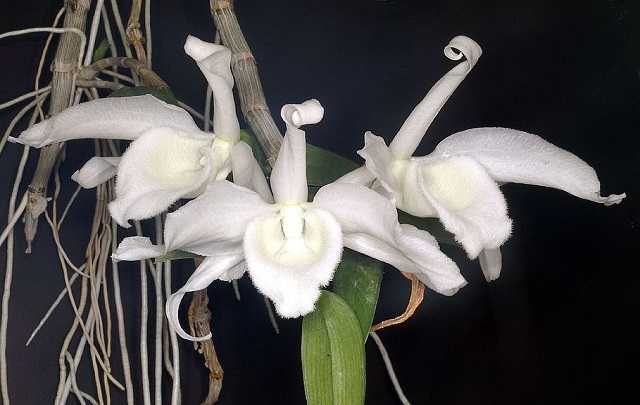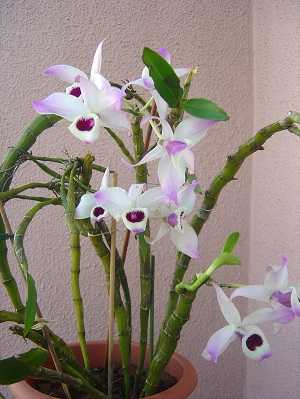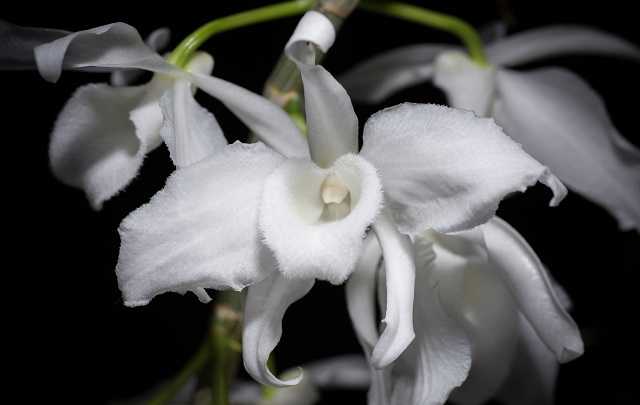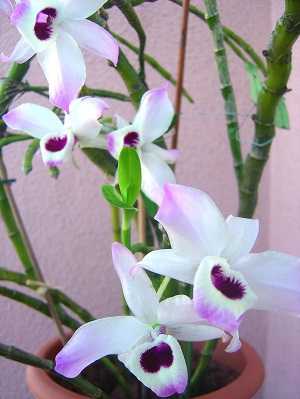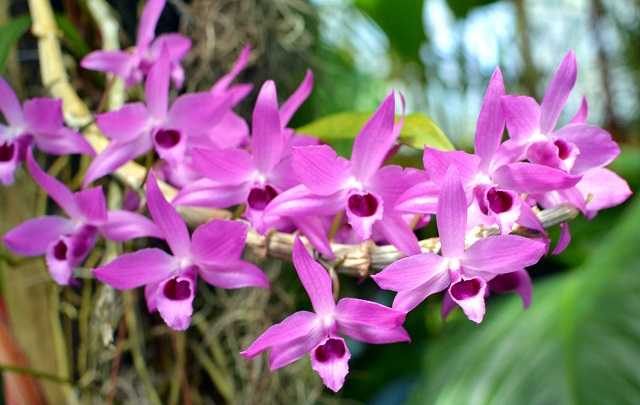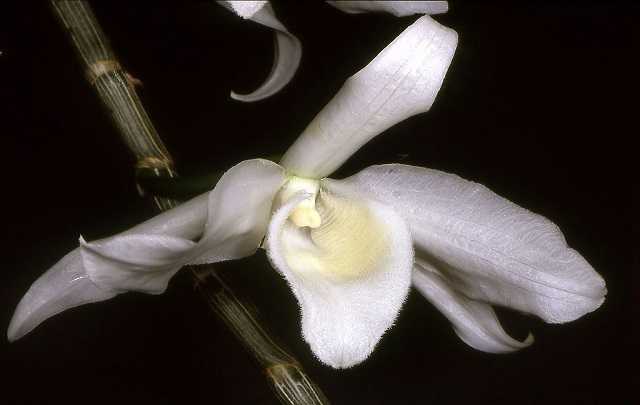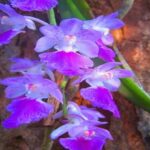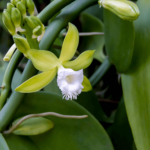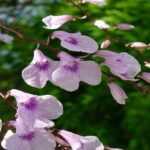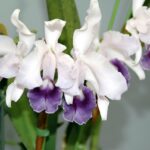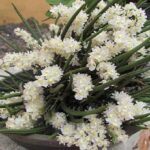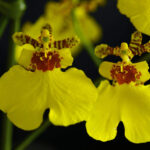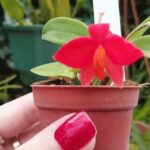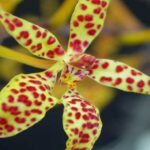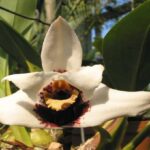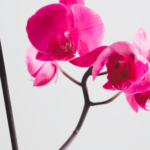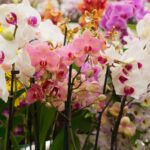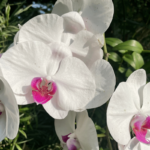The dendrobium anosmum is an epiphytic orchid described in the year 1845 by biologist Lindley.
This is a plant that can be found in forests ranging from 700 to 1300 meters (2296 to 4295 feet) above sea level in the following countries:
- Laos
- Philippines
- New Guinea
- Malaysia
- Vietnam
The Dendrobium anosmum orchid is considered large compared to other orchids.
This is because they reach an average of 39.4 to 51.2 inches (100 to 130cm).
Its leaves are deciduous and measure between 4.7 to 7.1 inches (12 to 18cm) in length.
Four very interesting facts about this orchid are:
- In Hawaii, they are known as Hono Hono Orchid.
- Anosmum means odorless in Latin, but this is an orchid that has a very pleasant smell during its flowering.
- There is an alba form of this orchid where the flowers are completely white.
- They are also known as dendrobium superbum.
If you want to learn how to care for and also some characteristics of this orchid, keep reading.
Learn How to Achieve Super Blooms on Your Orchids
🛑 If you love orchids and you're tired of not being able to make them bloom...
Then, know that thousands of beginner growers are achieving beautiful flowers on their orchids by following this method.
Click the button below to have beautiful orchids with show-worthy flowers every year. ⤵
How to Care for Dendrobium Anosmum
This is an orchid considered easy to cultivate, so you probably won’t have many difficulties taking care of it.
So that you can make your plant healthy and with several flowers, follow the tips below:
1. Watering
The dendrobium anosmum is a plant that depends a lot on its periods.
That is, during the growth period, cultivation will be very different from during the dormant period.
So, during the growth and flowering period (late winter to summer), do the following:
- Water abundantly; they are usually watered every day or every 2 days.
- Do not let the potting mix dry completely.
After flowering when the pseudobulbs shrink (early autumn), start reducing the amount of watering.
Gradually decrease so that your plant does not suffer from it.
Basically, during this period, you will let your plants dry out for a short period of time.
And in late winter, gradually increase your watering.
See also: Dendrobium Nobile Orchid Care
2. Lighting
Lighting is the most important factor for orchids to flower.
And in the case of this dendrobium, it is no different.
Below you will learn some tips on the lighting of this orchid that will make it have a stronger aroma.
But for now, know that it likes a lot of sunlight, but always indirect.
A light and diffuse light is recommended.
To know if your plant is receiving too much sunlight, follow these tips:
- If your leaf is darker green than normal, it needs more light.
- If your leaf is turning yellow and burning, it is getting too much sun.
But be careful not to be confused, because in the case of anosmum, it is common for the leaves to turn yellow during the dormant period.
3. Temperature
This is a plant that likes warmer temperatures.
Thanks to this characteristic, it became one of the most beloved orchids in Hawaii.
To grow it, it is recommended that you provide a temperature of:
- 79°F to 86°F (26ºC a 30ºC) during the day.
- 59°F to 68°F (15ºC a 20ºC) at night.
It is recommended to stimulate flowering that there is a drop of 44.6°F to 51.2°F (7ºC a 11ºC) from day to night.
See also:
- Dendrobium Moschatum – Curiosities, Photos and How to Care
- Dendrobium Thyrsiflorum – How to Care and Bloom
4. Humidity
Optimal humidity is very important to prevent pests and diseases.
Basically, if your orchid is in an environment with good humidity, it will be healthier and more resistant to diseases and pests.
The dendrobium anosmum is an orchid that likes medium to high humidity.
Basically, when your plant’s humidity is low, the tips of its roots will be short and may be burned.
On the other hand, in high humidity, it may be soft, and its roots are rotting, and in extreme cases, they will smell musty.
5. Where to Plant
Unlike dendrobium chrysotoxum, which likes clay pots, anosmum is a plant that likes to be suspended.
Therefore, two options in which it will adapt very well are:
- Cache-pot or hanging baskets.
- Trees
Now, if you want to grow them in pots, make sure your potting mixes have good drainage.
And also, put them in small pots.
But know that they will adapt much better in baskets or trees.
6. How to Repot
Like the vast majority of orchids, dendrobium anosmum needs to be repotted from time to time.
In this case, replanting occurs on average every 2 years.
This repotting is done after flowering.
You will notice that new roots are starting to grow, and you may find some seedlings (keikis).
This video will help you when repotting your dendrobium:
Do You Want to Learn How To Keep Your Orchids Healthy And Ready to Bloom Every Year?
So, I prepared a complete guide, step by step and illustrated, that will show you:
• The secrets to getting beautiful flowers every year
• How to fight and identify pests and diseases on your orchids
• THE MAGIC SUBSTANCE for orchids and how to use it
• And much, much more.
The great news is that the manual is now available at a super discount!!
But beware, it's only for the first buyers.
Click on MORE INFORMATION below and discover the secrets to show-worthy flowers. 👇
7. Fertilization
Now, regarding fertilization, it occurs in almost all periods of this plant.
The only time you should avoid fertilizing your anosmum is during its dormant period.
Basically, during the other periods, you will fertilize once a week with half strength with NPK 20 20 20 fertilizer.
In addition to this fertilizer, you can also look for other options or use organic fertilizers.
The fertilization of this orchid is very similar to that of dendrobium densiflorum.
Other Tips
And now some other tips that didn’t fit into the categories above.
If the leaves start to yellow and fall during the dormant period, don’t worry.
This happens because dendrobium anosmum is concentrating its energy on its pseudobulbs.
During spring, new leaves will grow.
And when your leaves are old, let them fall on their own, do not remove them.
This is because they can serve as food for the new pseudobulbs, and if you leave them, it can improve the next flowering.
Flowering
As already mentioned, this orchid has a flowering that stands out a lot for its fragrance.
They do not always have a smell, but when they do, they emit a strong and very pleasant smell.
Flowering usually occurs between spring and summer.
But this varies greatly depending on the location where this species is cultivated.
For example, in Hawaii, this orchid blooms from March to May.
A tip that some growers use to make it smell stronger is as follows:
- Expose it to intense sunlight (indirect light)
- Keep it in total darkness
But remember, they do this for a very short period, so be careful not to overdo it and end up attracting problems to your plant.
This orchid blooms only once a year, and after its flowering, it can produce seedlings just like phalaenopsis.
Flowers
Its flowers can be considered medium-sized.
They usually measure between 2.8 to 3.9 inches (7 to 10cm) in length, but this size can vary.
This dendrobium produces between 1 to 4 flowers per node, and normally, a total of 8 to 10 flowers appear.
These flowers are fragrant and can come in various colors, such as:
- Dark pink
- White (alba variety)
- Bluish-purple
Its lip usually has purple stripes, and in some cases, it has a heart shape.
Its flowers last an average of 3 weeks, but it is believed that if you grow it in colder temperatures, they can last longer.
Conclusion
This was the complete guide on dendrobium anosmum, how to take care of it, and also its main characteristics and curiosities.
If you have an orchid of this type, comment below telling us about your experience with it.
Now, if you want to keep learning about dendrobiums, see one of the articles below:
- Dendrobium Moniliforme
- Cooktown Orchid (Dendrobium bigibbum)
- Orchid Care for Beginners: Quick and Easy 7-Step Guide
Did you like this article? Then help us reach more people.
Click on the buttons below and share this article on your social networks.


